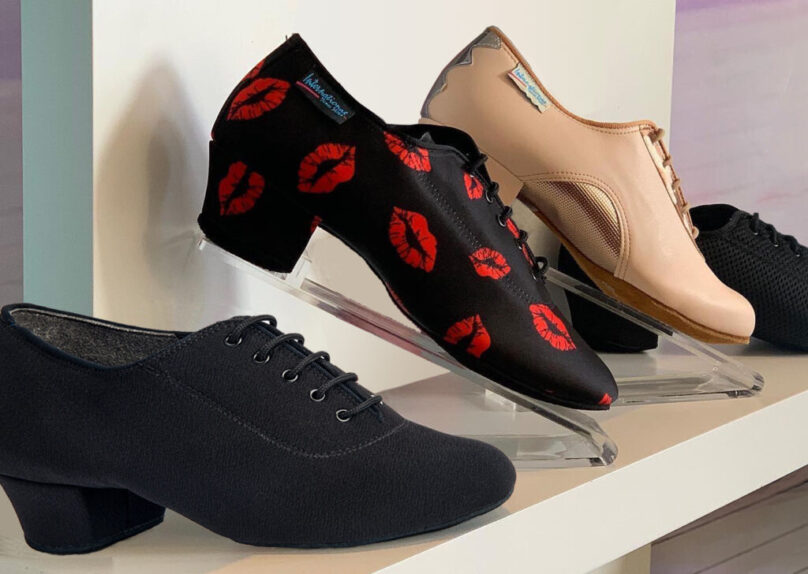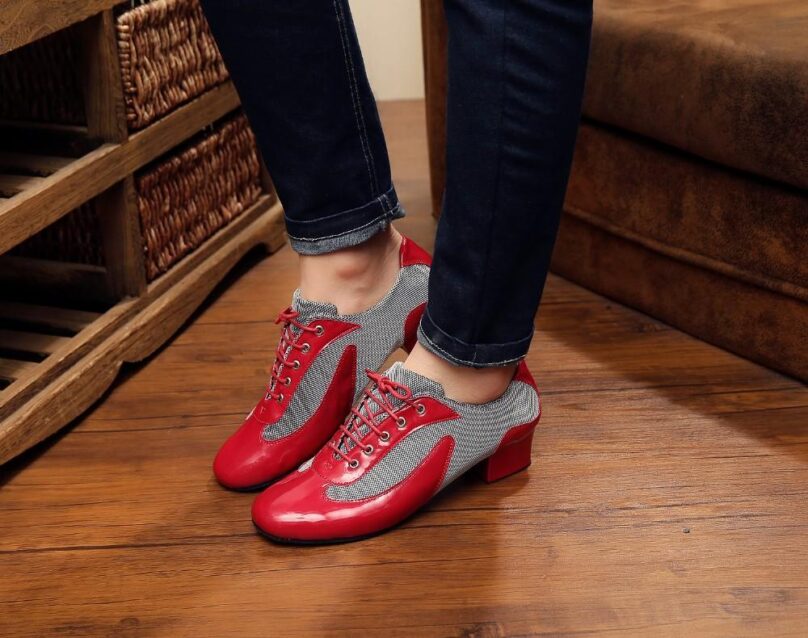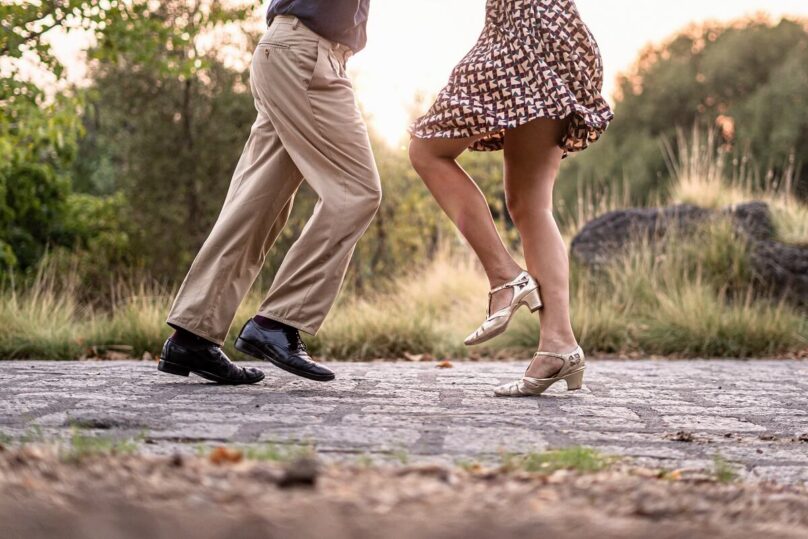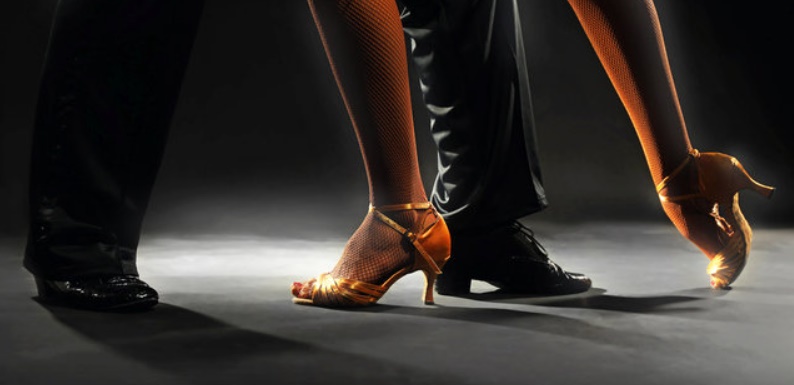When stepping onto the dance floor, the right shoes can make all the difference. Whether you’re a seasoned dancer or just starting, finding the perfect ballroom shoes is crucial. This guide will help you navigate the various styles and choose the pair that best suits your needs.
Table of Contents
1. The Classic Latin Shoes

Latin shoes are designed for dances like the cha-cha, rumba, and samba. These ballroom shoes typically have a higher heel, ranging from 2 to 3 inches, which helps with the hip movements essential in Latin dances. The open-toe design allows for greater flexibility and a better connection with the floor.
Key Features
- High Heel: Enhances hip movement and posture. The higher heel shifts your weight forward, encouraging the hips to move more freely. This design is particularly beneficial for Latin dances, which emphasize hip action and quick, sharp movements.
- Open-Toe: Provides flexibility and a strong floor connection. An open-toe design lets your toes spread out naturally, enhancing your balance and providing a better grip on the dance floor. This flexibility allows for more precise footwork and intricate dance steps.
- Snug Fit: Ensures stability and control. A snug fit prevents your feet from slipping inside the shoes, reducing the risk of injury. This tight fit also gives you better control over your movements, allowing for more accurate and confident steps.
Pros and Cons
- Pros: Excellent for Latin dances, enhances movement. These shoes help you achieve the dynamic and expressive movements required in Latin dances. The design supports the high-energy and fast-paced nature of dances like the cha-cha and samba.
- Cons: Less stability for beginners, not ideal for smooth dances. The higher heel can be challenging for new dancers to manage, potentially leading to balance issues. Additionally, these shoes are not suitable for smooth dances like the waltz or foxtrot, which require a different kind of support and flexibility.
The Versatile Standard Shoes

Standard or ballroom shoes are perfect for dances like the waltz, tango, and foxtrot. These shoes usually have a lower heel, around 1 to 1.5 inches for men and 2 inches for women, offering better balance and support. They have a closed-toe design, providing more protection and stability.
Key Features
- Low Heel: Offers better balance and support. The lower heel keeps your weight more evenly distributed, which helps with maintaining balance during smooth, flowing dances. This design is especially useful for beginners who need more stability.
- Closed-Toe: Provides protection and stability. The closed-toe design shields your toes from accidental bumps and provides additional support. This can be particularly helpful during intricate footwork, where precise toe placement is crucial.
- Cushioned Insole: Enhances comfort during long dances. A cushioned insole absorbs shock and reduces foot fatigue, allowing you to dance longer without discomfort. This feature is particularly beneficial during extended dance sessions or competitions.
Pros and Cons
- Pros: Great for beginners, more stable, versatile for various dances. The supportive design makes these shoes a good choice for those new to ballroom dancing. They are suitable for a wide range of dances, from the graceful waltz to the dramatic tango.
- Cons: Less flexibility compared to Latin shoes, might feel restrictive for some dancers. The structured design of standard shoes can feel restrictive to dancers used to the freedom of Latin shoes. Additionally, the closed-toe design may limit the range of motion for certain steps.
Practice Shoes

Practice shoes are a dancer’s best friend during rehearsals. They offer the comfort and support needed for long practice sessions without sacrificing style. These shoes often resemble standard ballroom shoes but with more cushioning and a more flexible sole.
Key Features
- Extra Cushioning: Provides comfort during extended wear. The additional padding helps to prevent foot fatigue and discomfort during long practice sessions. This makes it easier to focus on improving your technique rather than dealing with sore feet.
- Flexible Sole: Allows for a range of movements. A flexible sole lets your foot move more naturally, which is important for practicing different dance steps and styles. This flexibility can help improve your overall footwork and adaptability.
- Supportive Design: Reduces foot fatigue and injury risk. The supportive structure of practice shoes helps maintain proper alignment and reduces the risk of injuries. This is especially important during rigorous practice sessions where repetitive movements can lead to strain.
Pros and Cons
- Pros: Extremely comfortable, perfect for practice. These shoes provide the comfort and support needed for long hours of practice. They help you stay focused and energized, making your practice sessions more productive.
- Cons: Not suitable for formal performances, may lack the elegance of standard or Latin shoes. While great for practice, these shoes may not have the polished look required for performances. They might also lack some of the specific features needed for competitive dancing.
The Elegant Performance Shoes

When it’s showtime, performance shoes take center stage. These shoes are designed to dazzle the audience while providing the dancer with the necessary support. They come in various styles, often with decorative elements like rhinestones and intricate straps.
Key Features
- Decorative Elements: Adds sparkle and elegance. Performance shoes often feature embellishments that catch the light and draw attention to your feet. These details can enhance your overall look and make your performance more visually appealing.
- Supportive Heel: Balances aesthetics with function. While these shoes are designed to look good, they also provide the necessary support for your feet. The heel is carefully crafted to ensure stability and comfort during your performance.
- Custom Fit: Often made to measure for optimal performance. Custom-made shoes fit your feet perfectly, reducing the risk of discomfort and blisters. This personalized fit allows for better control and precision in your movements.
Pros and Cons
- Pros: Stunning appearance, tailored for performance. These shoes are designed to make you look your best on stage. They combine style and function, helping you perform with confidence and flair.
- Cons: Can be expensive, less practical for everyday use. The high cost of performance shoes can be a barrier for some dancers. Additionally, they may not be practical for regular practice sessions or casual dancing due to their decorative elements and tailored fit.
Men’s Ballroom Shoes

Men’s ballroom shoes come in different styles, catering to various dance forms. From the sleek, low-heeled shoes for standard dances to the slightly higher-heeled shoes for Latin dances, there is something for every male dancer.
Key Features
- Low Heel: Standard dances. Low-heeled shoes provide the stability and support needed for smooth dances like the waltz and foxtrot. They help maintain proper posture and balance, which is essential for these elegant dance styles.
- Slightly Higher Heel: Latin dances. A slightly higher heel is beneficial for Latin dances, as it enhances the hip movements and quick footwork required. This heel height helps create the dynamic and expressive movements characteristic of Latin dances.
- Sturdy Construction: Ensures durability and support. Men’s ballroom shoes are built to withstand the rigors of dance. The sturdy construction provides the necessary support and durability, ensuring they last through many dance sessions.
Pros and Cons
- Pros: Tailored to different dance styles, durable. These shoes are designed with the specific needs of male dancers in mind. They offer the support and durability required for both standard and Latin dances.
- Cons: Finding the right fit can be challenging, can be expensive. The variety of styles and fits available can make it difficult to find the perfect pair. Additionally, high-quality men’s ballroom shoes can be pricey, which may be a consideration for some dancers.
How to Choose the Right Shoe for You

Selecting the right ballroom shoe involves considering your dance style, comfort, and level of expertise. Here are some tips to help you make the best choice:
1. Know Your Dance Style
Different dances require different types of shoes. Identify whether you need shoes for Latin, standard, or both. Understanding your primary dance style will help narrow down your choices and ensure you select shoes that enhance your performance.
2. Prioritize Comfort
Comfort is key, especially if you plan to dance for hours. Look for shoes with adequate cushioning and support. Comfortable shoes will allow you to dance longer and prevent foot fatigue, making your dance experience more enjoyable.
3. Consider Your Experience Level
Beginners may benefit from more stable shoes, while experienced dancers might prefer shoes that offer more flexibility and freedom of movement. Assess your skill level and choose shoes that match your needs, ensuring you have the right balance of support and flexibility.
4. Try Before You Buy
Always try on shoes before purchasing. Walk, turn, and practice some dance steps to ensure they fit well and feel comfortable. Trying shoes on allows you to test their fit and comfort, ensuring you make the right choice for your dancing needs.
In Summary
Choosing the right ballroom shoes can elevate your dancing experience. From the elegant Latin shoes to versatile standard shoes, each style offers unique benefits. Remember to prioritize comfort and support, and don’t be afraid to invest in a good pair of shoes.
Related Posts:
- Which Deck is Easiest to Build: Choosing the Right…
- How Long Should You Play Video Slots? Finding the…
- Netflix Vs Disney Plus Compared: Which Is Better?
- 20 Smartest Animals in the World - Which One Has the…
- Which Country Has the Most Expensive Taxi Ride? 2024 Guide
- Advantages of Choosing in Right Metal Bed Frame for…













